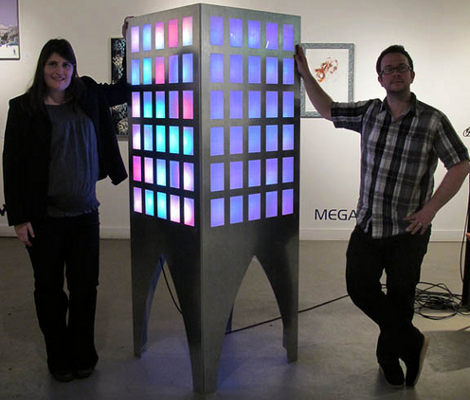
[Andrew & Deborah O’Malley] were tapped to created an interactive exhibit. The mission was to show that social problems take continual support from a lot of people before they can be solved. The piece needed to be architectural in nature, and they ended up building this touch-sensitive model building with individually lighted windows.
The project log that the [O’Malleys] posted shows a well executed battle plan. They used tools we’re all familiar with to achieve a highly polished and pleasing result. The planning stages involved a virtual mock-up using Google SketchUp. The details needed to order the shell from a fabricator were pulled from this early work, while the team set their sights on the electronics that shed light and that make the piece interactive. The former is provided by a Shiftbrite module for each window, the latter comes from the Capacitive Sensing Library for Arduino. Despite some difficulty in tuning the capacitive grid, and getting all of those Shiftbrites to talk to each other, the exhibit went swimmingly. It’s not hard to imagine how easy it is to start a conversation once attendees are attracted by the seductive powers of touch sensitive blinky lights.















They should have used 120 iphones.
^ hah, budgetary restraints . . . we thought of it, believe me!
Thanks for sharing on the site, HaD!
I’m most interested in how the capacitive touch sensing worked. It looks like they are using a matrix of row/column electrodes that consist simply of wires. I wonder if increasing the surface area of the electrodes in each cell would improve the sensitivity to touch (and thus improve the SNR). Because the light in the window should not be obscured, it might take some effort to come up with a suitable electrode, however.
Newbie’s guide to an “interactive art exhibit”
*Use an Arduino along with other development boards in your final design
*Use LEDs
*Put it in some sort of enclosure that looks familiar (an old TV, a building, a garden)
*Maybe involve some quirky way to interface with it
^ Feel free to show us how the pros do it, Drew!
@ColinB, finding the right balance between sensor surface area and lighting translucency is definitely a challenge.
Newbie’s guide to a “painting”
*Use a brush, roller, or maybe a sponge
*Use paint
*Put it on some sort of material that looks familiar (canvas, a piece of wood, paper)
*Maybe draw some fruit or a landscape or something.
I picture something like this installed on wall at home / Tic-Tac-Toe with the kids, they would have a blast!